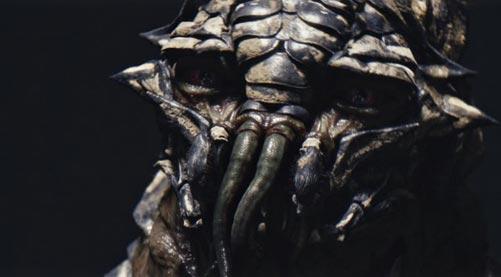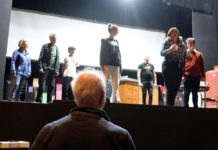Occasionally, a science fiction film manages to transcend its
genre and really has something to say. For example, racism was
tackled head-on in “Alien Nation,” (both the 1998 movie and the
long running television series). Decades after extraterrestrials
landed on earth, the humanoid “newcomers” finally achieved
semi-equal legal status with humans.
It is doubtful that the extraterrestrials in “District 9” will
ever achieve equal rights. These aliens have two strikes against
them—they look and sound like huge two-legged prawns, and they made
the mistake of having their mothership run out of fuel over
Johannesburg, South Africa. The country that dreamed up apartheid
has no trouble isolating the million plus prawns into a shanty town
on the city dump and then surrounding the place with barbed wire
fences and guard towers.
The film is shot in semi-documentary style, and the first few
minutes explains this background as well as how mobs of angry
humans have periodically invaded the slums to attack the prawns and
how Nigerian gangsters use the prawns fondness for cat food to
trade for illegal caches of alien super weapons. This documentary
is being made because the government has finally decided the best
way to handle the prawn problem is to relocate them to a clean, new
tent city far away from human contact.
Legal niceties must be followed however, so 24 hours before the
evacuation, a private company is given the responsibility of
notifying over a million households that they are being evicted and
relocated. The individual assigned to direct this operation, is a
cubicle worker named Wilkus Van De Merwe (Sharlto Copley), a
formerly faceless bureaucrat who just happens to be married to the
boss’s daughter.
Van De Merwe is not someone Americans will find likable. He does
his job as though it’s just like any quota to be filled. He uses
lots of sneaky tricks to get the prawns to sign the papers so that
things will be legal, while having a private army outfitted with
helicopters, machine guns and armored personnel carriers as his
enforcers. When Van De Merwe finds a nursery in one shack, he
explains to the cameraman how the carcass of a cow is suspended
from the ceiling and tubes provide nourishment to the infant prawns
nestled on the floor. “Watch,” he says as he unplugs the feeding
tubes. A few minutes later he is matter-of-factly describing how
the sounds you hear “like corn popping” are the prawn infants
exploding after the building is set on fire.
In short, Van De Merwe is an unlikely candidate to become an
alien advocate. But fate has something up its sleeve—when an
alien’s aerosol container sprays his face, sticky black liquid
drips from his nose, and his fingernails begin to fall out. He
returns home to a surprise party, eventually collapses on the floor
and wakes up in a medical facility with his left hand growing prawn
claws. “The transformation is well advanced,” says a white-coated
attendent.
Escaping the hospital, his private army is in close pursuit. Van
Der Were seeks refuge in the hut of a prawn he almost had arrested
a day earlier. “Hide me please,” he pleads, and this is where the
film gets really interesting.
Filmed in Johannesburg with a South African director, cast and
crew, the $35 million budget is miniscule by Hollywood standards,
but producer Peter Jackson demands excellence from everyone
involved and every dollar is on the screen.
He certainly gets value from Sharlto Copley. This previously
unknown actor is the centerpiece of the film, and he seamlessly
portrays a happily married everyman’s transformation into a
take-no-prisoners survivor in an Apartheid world where the alien
beings aren’t safely behind the barbed wire anymore.
Comments? E-mail gi*********@co*****.net.
48.8
F
Healdsburg
March 17, 2025








